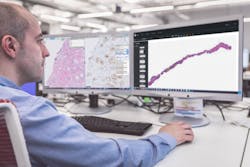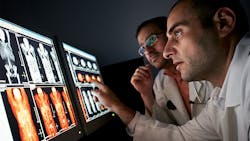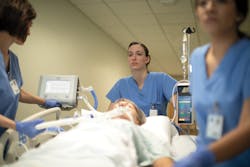Design Competence: Sean Carney on Data-Connected Solutions in Healthcare
As COVID-19 propelled digital technology to the forefront, there couldn’t have been a more fitting venue to address medtech trends than through a virtual Q&A session hosted by Collision from Home (June 23-25). But as one of 634 speakers featured on five channels of event programming streamed to 32,000 registrants, Carney would have to depend on his expertise in the use of artificial intelligence in healthcare design and delivery to vie for attention.
For Carney, that has meant paying close attention to the needs of the end-user—patients and staff—and placing them at the core of the design process. “We know that we’re not designing a Disney experience here,” said Carney. “People don’t want to be ill. We have to reflect on the different moods and have empathy with people and what they need.”
Fielding questions on how Philips is designing healthcare facilities around the world, disrupting cardiovascular surgery through 3D modeling and ramping up the production of ventilators in its effort to address global demand, Carney managed to extol the benefits of agile design within his organization’s matrix.
What follows is an abridged version of Carney’s Q&A session, which has been edited for clarity.
Q: What was the best innovation strategy employed during COVID-19 times in any of Philips’ verticals?
Sean Carney: Within Philips, verticals are known as business units. And one that was really on the frontline and has really been in the news for us, it is the ventilator business.
We realized very early on that the product platforms, although they were very robust, would do the job in an intensive-care situation to ventilate patients. They were never designed for mass volume in the way that you would design a consumer product.
There was already a cap on the volume we could potentially reach, even if we were to lay down new tools and new production lines. We needed the demand, and we needed to meet the demand of our customers and get patients on ventilators as quickly as possible. We then quickly relooked at the assets have could be repurposed to serve the needs of the patients and healthcare providers. We quickly came across continuous positive airway pressure (CPAP) machines, which were designed around sleep apnea patients or people with obstructive sleep apnea.
By reprogramming the software and by changing up a few components we could repurpose these machines into a rudimentary ventilator. They were always designed with scale in mind because there’s a huge market and a huge need for CPAP machines. So, we very quickly flipped that across; this was innovating on the fly. And where we had a few thousand capacity regular ventilators, we could now go to tens of thousands with these new, repurposed CPAP or BiPAP (bilevel positive airway pressure) machines.
The crisis has taught us that the candidates’ urgency and the call to action will [move] people to innovate. We had everybody volunteering, everybody leading. Everybody wanted to contribute towards this.
Q: What excites you in the design world?
SC: More than the superpowers of design is to make the intangible tangible—to help the company reframe an opportunity and look to the future. In the past, we’ve done blue sky concept projects, which have ended up as beautiful coffee-table books or models in the museum. But given that we’re working in healthcare, it’s far too important to just leave these things as coffee-table books.
When I create a vision, I want to see it come to life as soon as possible. And my frustration coming into the healthcare industry was always that it takes five years plus to get something through regulatory authorities to build something that’s got the right quality. Well, what this crisis has done is accelerate things.
When we were forecasting, we had our plans for 2025-2030. We are now seeing some of them beginning to happen in 2020 and 2021. We think 2025 is going to happen in 2021. A lot of that is around decentralized healthcare systems, such as cloud-connected, IoT-enabled devices and different ways in which you can deliver therapy.
For instance, patients don’t want to go into a hospital because they’re afraid they’re going to catch COVID-19. So, they’ve been putting off complaining about a chest pain or putting off the idea that a pain in the back may be a tumor. We saw only 30% of the normal reported cases of cancer in the Netherlands during the last three months compared to what we would typically expect to see. That’s not because we suddenly found the cure for cancer. It’s that people are not reporting it; they’re staying away.
What we expect now is a huge surge in demand for people to come in and get treatment. Hospitals will quickly get overwhelmed again, or people will have delays in getting treated. We have to find new and novel ways to treat them, which again is an opportunity to innovate. Some of the ideas that we had in planning for five years from now are being looked at to be executed in 2021.
Q: Can you share insights on some of the cutting-edge AI or machine learning already in the works?
SC: There are a number of spaces we’re looking at in AI and machine learning, but some of the most exciting ones are around digital pathology. So, think about the traditional way of looking at screens, for example. When you’re screening for cancer, you do a biopsy, you put this on the screen and then put it into a lab.
Then you basically have lines of people staring down into the slides, trying to spot anomalies at a cellular level. And, of course, it’s very easy for them to make mistakes and easy for them to miss things. Now, what if you train AI to do the same job in a fraction of a second, and it does it with almost 100% accuracy?
I think that’s an interesting example. And I think that AI coming into radiology, reading X-rays is another—not necessarily replacing the jobs of radiologists, but supplementing and taking over some of the more mundane roles and jobs and freeing them up to do other more meaningful work.
Q: Do you have any augmented reality projects?
SC: We’ve got quite a few. We’re designing hospitals and health facilities around the world. So, we build a virtual 3D model of the hospital and, before we even start laying foundations, we typically take the users of the building on an augmented reality walk through the building. For instance, a cardiac surgeon can evaluate whether he’s got enough space in his cardiac catheterization lab; we can look at patient flows; and we also use AI to simulate flows through that.
But what is really interesting is when we’re doing cardiovascular interventions and we’ve got a 3D model of the patient’s heart. We project it in 3D, which allows the cardiac surgeon to move around the heart and plan their intervention down to the finest detail. I think this is going to revolutionize the way surgeons work.




